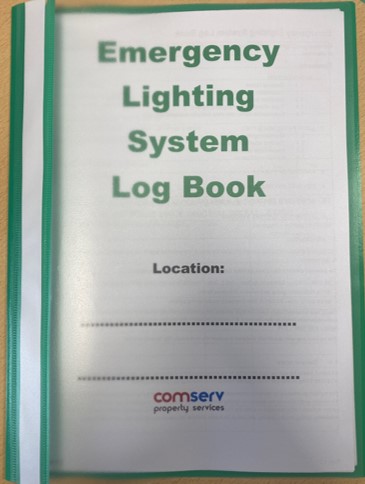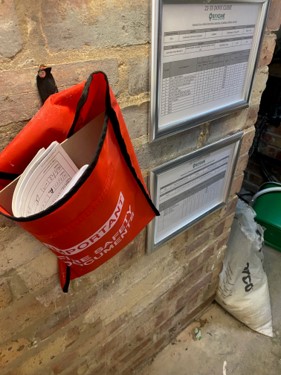On the 1 July 2023 Comserv took on the emergency lighting testing for our off-island working area. This consisted of 271 property addresses, which equated to 336 separate electrical installations that required the emergency lighting to be tested.
What does the Emergency Lighting Testing entail?
Comserv Electricians carry out a monthly drop test where they isolate the lights to see if the emergency fittings activate. We are also responsible for completing annual discharge tests, and this requires a full 3 hour discharge of the batteries to ensure the lights last for the required time. If we identify any defects at any point these are booked in as soon as the materials are available.
Identifying issues
Prior to beginning work, we completed an initial sample survey of the sites to determine the potential works required and to identify any trends that would impact the service from day one. Of the sites we investigated we found that a number of emergency lighting Log Books were missing or that 90% of the pages had been previously completed, so a new Log Book would be required within the next 3 to 4 visits. We also identified that the current Emergency lighting Log Books in use and those available on the market, would not suit our requirements, and would be costly to procure going forwards as they would only last around two years.
 Developing a Comserv Emergency Lighting Log Book
Developing a Comserv Emergency Lighting Log Book
With the support of the Electrical Supervisors the team developed our own Comserv Emergency Lighting Log Book, which we have future-proofed to last 6 years before any amendment or additional pages will be required. The book meets all the standard requirements of BS 5266-1 and includes an adoption certification and 6 Annual test certificates.
336 Log Books have been created by the Electrical Resource Coordinators. Each Log Book consists of 24 pages of information and certification.
We also implemented a new tracking sheet to assist the electrical team and capture key information to support our understating on the sites and the schemes now under our management.
Managing the Work
We had to consider how we would manage this work. A complete review of the site addresses was undertaken alongside each of the Comserv Electricians' home addresses. We then assigned the sites to the relevant Operatives, and for those Operatives that did not live on the patch, the properties closest to them on their way to work were assigned. Each of the 16 Operatives have on average, 19 addresses to test.
A Toolbox Talk was held with the Operatives to confirm the work requirements and how we intended to manage the service. This was all centred around a keen focus on each Operative taking ownership of their sites. This will ensure that familiarity of the sites and locations is enhanced to support productivity out in the field.
The Toolbox Talk also highlighted the current issues and the key tasks and information we needed to capture. This included sharing the issues identified with the current Log Books and the requirements of the new ones that were going to be introduced. In addition, a laminated guidance sheet was produced which included a list of each of the addresses assigned to each Operative. This was to enable the Operatives to assist the Resource Coordinators in confirming the next location to test.
Scope of Emergency Testing and What We Achieved in the First Month
Across the 336 Installations we are now testing 5281 emergency light fittings every month. The largest number of lights in one of the schemes is 125 fittings, but we also have a small site with just 2 fittings to test, so they do vary significantly.
Within the first month Comserv’s team carried out the following:
- 120 component repairs to rectify faults that we identified
- Installed 51 New Log Books
- Put in place 18 new Important Safety Document Wallets. These hold the Log Books within the electrical cupboards/main switch rooms
- Completed 100% of the tests, and 100% of the repairs within the same period
- Captured circa 800 photos of the Emergency Lighting Adoptions certificates, Annual certificates or the Event Log Book
- Identified 1 address fault within the PCC system, reducing our responsibility to 270 properties
- Labelled the emergency light fittings at approximately 40% of the sites to support future tests and repairs. By labelling the lights it speeds up the testing, the update, and especially the repairs if another Operative is sent to that site to carry out the work

Using Data to Plan the Scope of Works for the following Month
We used all the data captured within the first month, to confirm the scope of works for August. This included the names of the Operative, how many Log Books needed to be installed, or if they had already been installed, and the block numbers corresponding to each Log Book.
Future developments to Support the Emergency Lighting Testing
In order to work more efficiently and in accordance with our Systems Thinking principles Comserv are already working on future developments to support the Emergency Lighting Testing works.
We are working with our IT provider to enable the Operatives to take more than 2 pictures per visit, as currently on the larger scheme, we have to raise multiple visits to capture some of the key Test Certificate photos.
Our IT Provider is also supporting some development work to help extract the photos from the system, in a format that will support the uploading of the certificates to the client’s database.
We are also exploring ways in which we can automatically create the jobs within the client’s database. At present we have to manually raise 270 jobs in both systems each month.
At the time of writing (21 August 2023) we were beginning to raise the jobs for September, and each Operative is focused on installing a fully completed new Emergency Lighting Log Book or books at each of the addresses.
